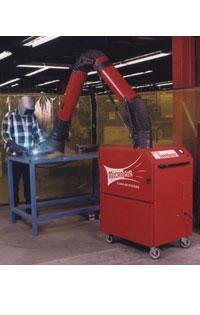Industrial air filters reduce the number of particles in the air that passes through them. Air filtration supplies the means to reduce the level of particulates in the air to a cleanliness standard required by any definition of "air conditioning." It extends from the simple task of preventing lint and other debris from plugging heating / cooling coils to removing particles as small as 0.1 micron which could cause a short circuit on microchips.
Industrial air filters can come in many configurations, these include: bag filters, box filters, fan filters, HEPA or ULPA filters, filter media, panel filters and pre-filters. A bag filter is a fabric bag through which a gas stream is passed for the removal of particulate matter. A box filter is a box that has filter media fitted into it. Fan filters are usually made from fiberglass or mesh type materials and are intended to prevent the accumulation of lint and other large particles from occurring around the motor and fan. High Efficiency Particulate Air (HEPA) / Ultra Low Particulate Air (ULPA) filters capable of screening out particles larger than 0.3 µm. HEPA filters are used in laminar air flow cabinets (hoods) for sterile transfer work. Filter media is a mat of fibers that provide a barrier to particles entrained in the flow of air or gas. Common configurations include bulk rolls, pads, re-loadable frames, etc. Panel filters are usually made from fiberglass or mesh type materials and are intended to prevent the accumulation of lint and other large particles from occurring in and around heating and ventilation systems. Pre-filters are traditionally depth filters placed before a filter to significantly reduce the particulate loading in the system and thereby allow the filter to operate efficiently at a light particulate loading. Depending on the supplier the frame for the filter may or may not be included in the assembly.
There are several important specifications to consider when looking for industrial air filters. These include porosity, efficiency, filter length, height and width or ring size, and ply. Filter porosity is measured in ppi (average number of pores-per-linear-inch.) The range of ppi provides an open cell with little air restriction to a fine-celled foam for maximum particulate filtration. Efficiency is the ability of the filter to remove a certain amount of particles of a certain size at certain airflow. Most residential filters measure 1" in width, while commercially fitted filters are normally 2". Most filters are standard sizes and shapes. Round bag filters are specified in length and ring size. Ply refers to the layers of media contained in the filter. Ply can be anywhere from one up to five and sometimes greater than five.
There are many types of materials available for industrial air filters. These include, but are not limited to, acrylic, activated carbon, aluminum wire screen, electrostatic fabric, fiberglass, paper, polyurethane foam, polyester and poly/cotton non-woven materials. There are several features that are common to industrial air filters. Filters can offer EMI/RFI protection. Some filters are configured for use in a cleanroom. It is common for filters to be disposable after one use they are not reusable. Industrial air filters are commonly high capacity; they filter high amounts of particles at high airflows. Filters can be multi-pocket and pleated. Often samples will clog filters prematurely and multiple filters may be needed to process single batches, increasing the costs of filtration so pre-filters are used. Many times the filter media will be replaceable while the frame is kept. Reusable filters can be washed for multiple uses. Inlet air filters are also available.
Filtration for pneumatic systems: in most industrial pneumatics, compressed air is supplied from a single compressor to a large number of operating systems, as a plant resource, much like light or electricity. Individual filters are used on the separate systems -- sometimes more than one filter per system. Often the filters are found in conjunction with regulators and sometimes lubricators comprising a filter-regulator-lubricator (frl) for the system.
Filters are rated on the ability to retain contaminants of certain size levels.
http://www.globalspec.com/LearnMore/Manufacturing_Process_Equipment/Filtration_Separation_Products/Air_Filters
http://www.globalspec.com/Supplier/Profile/MicroAir
